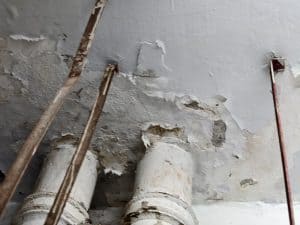When we talk about the health of buildings, “wall cancer” is a commonly overlooked yet highly destructive phenomenon. It not only affects the appearance of walls but can also lead to structural damage, deteriorate the living environment, and even pose risks to human health. This article explores what wall cancer is, its causes and impacts, and how epoxy resin can effectively resolve the issue by restoring wall stability and waterproofing.
🧱 What Is Wall Cancer?
“Wall cancer” is a colloquial term for wall deterioration, referring to issues such as peeling, bubbling, powdering, and discoloration caused by moisture, water infiltration, or salt erosion. The term draws from its destructive and spreading nature, resembling how cancer spreads across a wall.

Wall cancer commonly occurs in the following scenarios:
- High-humidity environments like bathrooms and kitchens
- Exterior walls exposed to prolonged rainfall
- Basement walls or walls close to the ground
- Failed waterproofing layers or construction defects
Its main causes include:
- Moisture penetrating the wall, causing salts in the cement to migrate to the surface
- Salt crystallization and expansion, damaging the wall structure
- Mold growth, leading to discoloration and unpleasant odors
Wall cancer not only affects the wall’s appearance but can also loosen the structure, corrode rebar, and impact residents’ respiratory health.
🔍 How to Identify Wall Cancer
Identifying wall cancer is not difficult. Common symptoms include:
- White powder or crystalline deposits on the wall (commonly called “salt flowers”)
- Peeling, bubbling, or discoloration of paint
- Damp walls with visible water stains
- Powdery surface that crumbles upon touch
- Presence of mold or unpleasant odors
If any of these signs are observed, prompt treatment is necessary to prevent further spread.
🧪 The Key to Resolving Wall Cancer: Epoxy Resin Repair Technology
Traditional methods of treating wall cancer often involve scraping off the damaged layer, reapplying plaster, or repainting. However, if the root cause—moisture infiltration—is not addressed, wall cancer will recur. Therefore, choosing repair materials with waterproofing, adhesion, and durability is essential.
Epoxy resin is a high-performance synthetic material with the following advantages:
- Strong adhesion: Bonds firmly with cement, brick walls, and other substrates to prevent peeling.
- Excellent waterproofing: Forms a sealed layer that blocks moisture from re-entering the wall.
- Chemical and salt resistance: Withstands damage from salt crystallization.
- High mechanical strength: Hardens into a tough layer that reinforces wall stability.
- Low shrinkage: Prevents new cracks after repair.
These properties make epoxy resin an ideal material for treating wall cancer, especially in high-humidity environments like bathrooms, basements, and exterior walls.
🛠 Wall Cancer Repair Process (Using Epoxy Resin)
Here are the general steps for treating wall cancer with epoxy resin:
- Remove the damaged layer
Thoroughly remove the affected area, including peeling paint, powdery cement, salt deposits, and mold. Use tools like scrapers, wire brushes, or high-pressure water jets. - Dry the wall surface
Although some epoxy resin products can be applied to damp surfaces, it’s recommended to use fans or dehumidifiers to dry the wall for optimal results. - Apply epoxy primer
Coat the wall with epoxy primer to enhance adhesion and seal capillaries, preventing further moisture infiltration. - Patch and repair
For dents or cracks, use epoxy resin mortar—a mix of epoxy resin and fine sand—to patch and level the surface. This mortar offers excellent bonding and waterproofing. - Surface coating
After repairs, apply epoxy topcoat or waterproof paint to form a protective layer, improving durability and aesthetics.
💡 Tips and Recommendations
- Choose the right formula: Different epoxy resin products vary in viscosity, curing time, and application conditions. Select based on wall conditions.
- Temperature and humidity: Some epoxy resins require specific temperature and humidity for application. Follow product instructions.
- Safety precautions: Wear gloves, masks, and goggles during application to avoid skin contact or inhalation of fumes.
- Avoid mixing materials: Do not randomly mix epoxy resin with cement mortar, as it may affect curing and adhesion.
🌧 Advantages in High-Humidity Environments
Wall cancer is most common in humid environments, and traditional repair materials often fail on damp surfaces due to poor adhesion. Epoxy resin’s unique formulation (such as Lypox CR ) allows it to cure stably even on moist walls, forming a waterproof barrier that prevents further moisture intrusion.
The following applications are especially suitable for using epoxy resin:
- Bathroom wall repairs
- Basement waterproofing
- Exterior wall leak repairs
- Kitchen wall moisture reinforcement
By applying epoxy resin, wall cancer can be effectively treated while enhancing the wall’s overall waterproofing and durability.

🏠 Conclusion: Wall Cancer Is Not Incurable—Epoxy Resin Is the Solution
Though wall cancer is highly destructive, it is not impossible to cure. The key lies in correctly identifying the cause, thoroughly removing the damaged layer, and choosing repair materials with waterproofing and adhesion properties. Epoxy resin, with its outstanding physical and chemical characteristics, is the top choice for treating wall cancer.
Whether for residential walls, commercial spaces, or industrial buildings, following the proper repair process and using the right materials can effectively control and restore wall cancer, bringing back a healthy and beautiful wall. Choosing epoxy resin means choosing a stable, durable, and waterproof solution.
